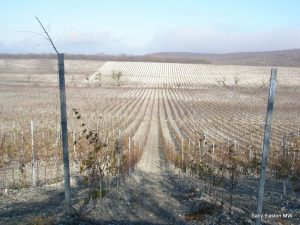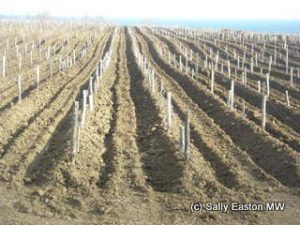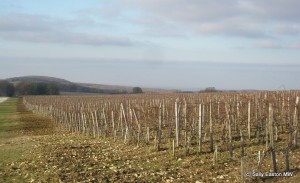Russian revolution

Vineyards overlooking Novorossiysk on the Black Sea
A version of this appeared on The Drinks Business.
Russia may be the largest country in the world but much of it is too cold for sustainable viticulture, with winters getting down to -15 to -30°C. Vines can tolerate -15°C but they’re dead in the water at -30°C. A short growing season restricts the choice of cultivars further.
The exception to this situation is in the far south-western corners of the country, around Anapa and Novorossiysk on the north-eastern tip of the Black Sea, which coincidentally runs along the 45th parallel, famed further west for being home to Piedmont, the Rhône valley and Bordeaux. This focus area for viticulture is the Krasnodar region, one of four main designated wine-producing regions.
Two of the other regions – Stavropol and Dagestan – stretch eastwards either side of the 45th parallel, immediately north of the Caucasus Mountains to the Caspian Sea. Georgia abuts these regions to the south. The fourth Russian region is some way north of Krasnodar region and the Black Sea, around Rostov-on-Don, in a climate so continental that viticulture takes on unique attributes.
Temperatures in Krasnodar region’s Taman Peninsula, by the Azov Sea, can vary annually from around -15°C to 40°C. When the wind blows from central Russia, from Siberia, it goes to the Taman Peninsula, largely being deflected from the north coast of the Black Sea, around Anapa and Novorossiysk, by the western tail end of the approximately east-west running Caucasus mountains.

Recent vineyard investment on the Black Sea
Kuban-Vino is a prominent producer in Taman. Their viticulturalist, Maxim Gruner, explained “the problem of this terrritory, is that once in 10-12 years we get a cold winter, -24 to -26C. Some vines die.“ They do, however have wide selection of vines including chardonnay, sauvignon blanc, riesling, cabernet sauvignon, merlot, pinot blanc, syrah and muscat, plus the more regional saperavi and krasnostop. The modern era of the internationalising Russian wine industry provides a prosaic learning curve, as Gruner said “last year [2011/’12] was a cold winter. We had three clones of syrah. Two froze and one made it, so we know we can work with that one.“ The biggest challenge here, he emphasised “is the cold winters, especially when the very cold comes suddenly and kills the vines.” In 2006/7 Kuban-Vino lost 1,600 hectares of vines, out of their about 6,500 hectares. “Vines don’t get old here” Gruner said wryly. The average vine age generally in Russia appears to be about 25 years.
But the benefits clearly outweigh the risks. Gruner said “the temperature is relatively high here, it’s the warmest place in the whole region because it’s close to the sea – we have about 300 sunny days a year, and the wind in the sea channel cleans the vineyards and keeps them fresh.”
An hour or two east along the Black Sea coast, and the western tail end of the Caucasus creates two viticultural zones. The mountains protect the commercial port city of Novorossiysk from the cold northerly winds, and the Black Sea keeps the temperatures up. One of the country’s oldest wineries, Myskhako, is in this warmer spot. Then just behind the hills is a cooler area and it is up here where the likes of Château le Grand Vostock and the recently planted Lefkadia and Villa Victoria are located.
Varietal adaptation to the winter freeze
The winter freeze defines viticulture, and grape varieties, in Russia. Hybrids, such as saperavi severny were bred to withstand the winters, making it a popular choice in the Rostov region. This variety is different from the Georgian cultivar saperavi.

Vines buried against the winter freeze
Indigenous varieties such as krasnostop, tsimylianskiy chorni and sibirkovy are well adapted to the cold. But international varieties are puny by comparison, and always require burying to survive winter. It is in the Rostov region that the winter freeze takes on a life and rhythm of its own. Summers may reach 40°C, but winters get down to -30°C and the approximately 350mm of annual precipitation mostly falls as snow.
This is the region where the more cold-tolerant indigenous varieties come into their own, as well as hybrids, which provide fruit for local table wine. The hybrids, such as golubok and saperavi severny don’t need to be buried – they have thick permanent wood having been bred to survive these temperatures.
Tsimlianskiy Wines general manager, Igor Gubin, explained the process. “we take the vines off the wires, then lay down the vines and cover them with soil using a tractor. It costs about US$500/ha to cover and uncover them.” The vines are covered by November 15th and uncovered by the end of March. This means the growing season is effectively April to August/September. The winter freeze even informs the planting density, the machines don’t allow a tighter density than 2m rows x 1.5m between the vines.
International consultants
The new era of Russian viticulture is mainly a feature of the new millennium. Another feature of any aspiring winery is the international consultant. John Worontschak is a profilic consultant in Russia, having started work in 2002 with Myskhako, a 600 hectare property founded in 1869. It is by the Black Sea, near Novorussiysk, and Worontschak stayed on on even when the company changed hands. Since then he’s added to his Russian portfolio, Fanagoria, and Villa Victoria, an 80ha ‘boutique’ winery which is owned by Sergei Yanov, one of the directors of Myskhako.
In a story that’s already known from other re-emerging regions, some of the quickest wins are in the winery. “Without question” Worontschak said, “oxygen management immediately improved quality and shelf life. Initial oxygen levels were approaching saturation point in the old days. We are now down to 1-3 mg/l post bottling as opposed to 6-8. It’s still high-ish but it’s much better.”

Château le Grand Vostock
The first Spanish winemaking consultant in Russia, Rubén Sáenz of Bodegas San Prudencio in Rioja, has similarly made a huge difference in the winery in just his first year, with, by a western benchmark, some standard attention to detail, hygiene, oxygen and temperature control and more reductive protocols at Tsimlianskiy Winery in the Rostov region, which marks the northern point of wine production in Russia. His achievements are a reminder of the white winemaking revolution in Spain of the 1990s where the likes of albarino and verdejo came freshly into the sunshine after their former oxidative selves had received some modern winemaking attention. “Quality is new for these people” Sáenz summarised, and it is being sought out.
Frenchman Patrick Léon consults at expense-no-object winery and future spa resort Lefkadia, founded in 2007 among the foothills of the Caucasus some 140-200m up behind Novorossiysk, back in Krasnodar region, where summer daytime temperatures reach 35-40°C. Alcohol norm here is around 14%.
More than 30 grape varieties were planted, and only gruner veltliner has already not worked, though commercial decisions will wait until they have five years of experience under their belts. Owner Mikhael Nikolaev said early trials were showing “petit verdot gives rich flavour; cabernet sauvignon is ‘good’ but not brilliant in our area; pinot noir looks Chilean or Californian with dried fruit, it’s not a Burgundy style here, we don’t have cold nights; and sangiovese is not giving the best results in our climate.”
Even here, though winters can bite occasionally. In January 2012, viticulturalist Dmitri Kocharidi said “temperatures got down to -27°C and while we didn’t lose hectares of vines – they recovered – we did lose harvest, about 35% of the crop.” It was not a typical winter he added. At nearby Château le Grand Vostock they lost 10% of their vines and the rest recovered. It’s not usual practice to bury vines in this warmer part of Russia, though Lefkadia had started buttressing soil above the graft union as some partial protection, after two deep colds in 2010 and 2012.
Entry versus premium
Another of the recent trends is an acknowledgment of the need to separate entry level wines from premium product, the latter of which is made almost entirely from home-grown raw material, and represents the opportunity for Russia to show wine with real Russian identity. The Union of the Oenologists and Winemakers of Russia reported wine production in 2011 was 7.3 Mhl including 2.2 Mhl of sparkling wine. On top of this was an additional 2.2 Mhl of imported juice and wine, virtually all of which went into the production of the entry level segment.
Leonid Popovich, who heads up the Union of the Oenologists and Winemakers of Russia, said “the intensive development of the premium sector began only 15 years ago, and we can see tangible results only for the last 2-3 years. The results of participation of Russian wines in international competitions show a steady annual increase in the quality of our wines and this gives us hope that the quality of Russian wines will continue to grow.” He added it would likely take another 10-15 years for the premium sector to gain traction, and the “main thing at the moment is to win [share] from wines imported to Russia.”
Any terroir expression is going to come from this premium segment. Worontschak said there are “definite differences between Novorossiysk and the Taman Peninsula both in soils and climate [with] Novorossiysk being warmer and traditionally considered better, and with the Taman peninsula seen as being weaker.” But Worontschak disagrees with this accepted wisdom, saying “I believe some of the most complex and delicate wines will come from Taman. I would imagine as winemaking improves the sparkling bases, rieslings etc will predominate here with high quality full bodied whites and reds being made around Novorossiysk.”
The Russian vineyard
| Region | Hectares |
| Krasnodar | 23,400 |
| Dagestan | 22,700 |
| Stavropol | 7,000 |
| Rostov | 5,000 |
| Other regions | 4,900 |
| Total Russian vineyard area | 63,000 |
Source: The Union of the Oenologists and Winemakers of Russia, 2011 data (most recent available)
My visit to Russia was sponsored by the Union of the Oenologists and Winemakers of Russia.



